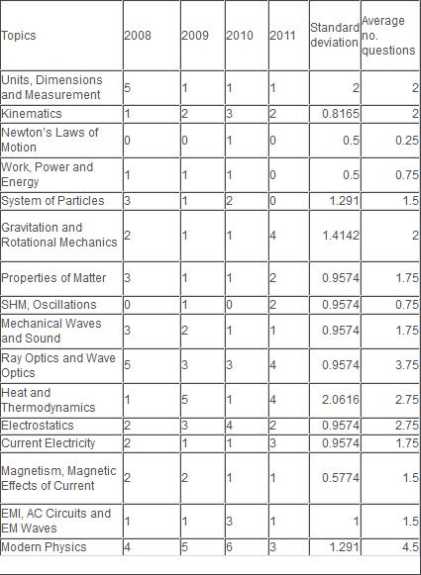|
#1
| |||
| |||
|
Which are the important Chapters for AIEEE Physics, can you provide here the list?
|
|
#2
| |||
| |||
|
First of all i am telling you that the AIEEE is replaced from IIT JEE Main Exam. This is the list of important chapters for IIT JEE Main Physics exam: Units, Dimensions and Measurement Kinematics Newton’s Laws of Motion Work, Power and Energy System of Particles Gravitation and Rotational Mechanics Properties of Matter SHM, Oscillations Mechanical Waves and Sound Ray Optics and Wave Optics Heat and Thermodynamics Electrostatics Current Electricity Magnetism, Magnetic Effects of Current EMI, AC Circuits and EM Waves Modern Physics 
__________________ Answered By StudyChaCha Member |
|
#3
| |||
| |||
|
As you want I am here telling you about the Chapter important for Physics paper for AIEEE exam. Physics Syllabus: Unit 1 : Physics and Measurement : Physics, technology and society, S I units, Fundamental and derived units. Least count, accuracy and precision of measuring instruments, Errors in measurement, Dimensions of Physical quantities, dimensional analysis and its applications. Unit 2 : Kinematics : Frame of reference. Motion in a straight line: Position – time graph, speed and velocity.Uniform and non – uniform motion, average speed and instantaneous velocity Uniformly accelerated motion, velocity – time, position – time graphs, relations for uniformly accelerated motion. Scalars and Vectors, Vector addition and Subtraction, Zero Vector, Scalar and Vector products, Unit Vector, Resolution of a Vector. Relative Velocity, Motion in a plane, Projectile Motion, Uniform Circular Motion. Unit 3 : Laws of Motion : Force and Inertia, Newton’s First Law of motion; Momentum, Newton’s Second Law of motion; Impulse; Newton’s Third Law of motion. Law of conservation of linear momentum and its applications, Equilibrium of concurrent forces. Static and Kinetic friction, laws of friction, rolling friction. Dynamics of uniform circular motion: Centripetal force and its applications. Unit 4 : Work, Energy and Power : Work done by a constant force and a variable force; kinetic and potential energies, work – energy theorem, power. Potential energy of a spring, conservation of mechanical energy, conservative and non – conservative forces; Elastic and inelastic collisions in one and two dimensions. Unit 5 : Rotational Motion : Centre of mass of a two – particle system, Centre of mass of a rigid body; Basic concepts of rotational motion; moment of a force, torque, angular momentum, conservation of angular momentum and its applications; moment of inertia, radius of gyration. Values of moments of inertia for simple geometrical objects, parallel and perpendicular axes theorems and their applications. Rigid body rotation, equations of rotational motion. Unit 6 : Gravitation : The universal law of gravitation. Acceleration due to gravity and its variation with altitude and depth. Kepler’s laws of planetary motion. Gravitational potential energy; gravitational potential. Escape velocity. Orbital velocity of a satellite. Geo – stationary satellites. Unit 7 : Properties of Solids and Liquids : Elastic behaviour, Stress – strain relationship, Hooke’s Law, Young’s modulus, bulk modulus, modulus of rigidity. Pressure due to a fluid column; Pascal’s law and its applications. Viscosity, Stokes’ law, terminal velocity, streamline and turbulent flow, Reynolds number. Bernoulli’s principle and its applications. Surface energy and surface tension, angle of contact, application of surface tension – drops, bubbles and capillary rise. Heat, temperature, thermal expansion; specific heat capacity, calorimetry; change of state, latent heat. Heat transfer – conduction, convection and radiation, Newton’s law of cooling. Unit 8 : Thermodynamics : Thermal equilibrium, zeroth law of thermodynamics, concept of temperature. Heat, work and internal energy. First law of thermodynamics. Second law of thermodynamics : reversible and irreversible processes. Carnot engine and its efficiency. Unit 9 : Kinetic Theory of Gases : Equation of state of a perfect gas, work done on compressing a gas. Kinetic theory of gases – assumptions, concept of pressure. Kinetic energy and temperature: rms speed of gas molecules; Degrees of freedom, Law of equipartition of energy, applications to specific heat capacities of gases; Mean free path, Avogadro’s number. Unit 10 : Oscillations and Waves : Periodic motion – period, frequency, displacement as a function of time. Periodic functions. Simple harmonic motion (S.H.M.) and its equation; phase; oscillations of a spring – restoring force and force constant; energy in S.H.M. – kinetic and potential energies; Simple pendulum – derivation of expression for its time period; Free, forced and damped oscillations, resonance. Wave motion : Longitudinal and transverse waves, speed of a wave. Displacement relation for a progressive wave. Principle of superposition of waves, reflection of waves, Standing waves in strings and organ pipes, fundamental mode and harmonics, Beats, Doppler effect in sound. Unit 11 : Electrostatics : Electric Charges : Conservation of charge, Coulomb’s law – forces between two point charges, forces between multiple charges; superposition principle and continuous charge distribution. Electric field : Electric field due to a point charge, Electric field lines, Electric dipole, Electric field due to a dipole, Torque on a dipole in a uniform electric field.Electric flux, Gauss’s law and its applications to find field due to infinitely long uniformly charged straight wire, uniformly charged infinite plane sheet and uniformly charged thin spherical shell. Electric potential and its calculation for a point charge, electric dipole and system of charges; Equipotential surfaces, Electrical potential energy of a system of two point charges in an electrostatic field. Conductors and insulators, Dielectrics and electric polarization, capacitor, combination of capacitors in series and in parallel, capacitance of a parallel plate capacitor with and without di electric medium between the plates, Energy stored in a capacitor.
__________________ Answered By StudyChaCha Member |